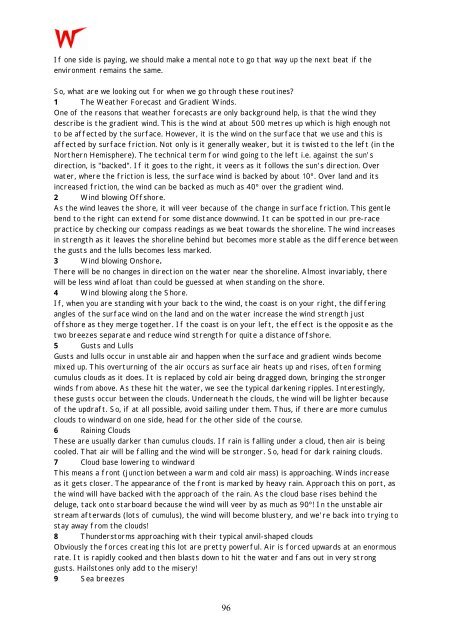File - Canadian Wayfarer Association
File - Canadian Wayfarer Association
File - Canadian Wayfarer Association
You also want an ePaper? Increase the reach of your titles
YUMPU automatically turns print PDFs into web optimized ePapers that Google loves.
If one side is paying, we should make a mental note to go that way up the next beat if the<br />
environment remains the same.<br />
So, what are we looking out for when we go through these routines?<br />
1 The Weather Forecast and Gradient Winds.<br />
One of the reasons that weather forecasts are only background help, is that the wind they<br />
describe is the gradient wind. This is the wind at about 500 metres up which is high enough not<br />
to be affected by the surface. However, it is the wind on the surface that we use and this is<br />
affected by surface friction. Not only is it generally weaker, but it is twisted to the left (in the<br />
Northern Hemisphere). The technical term for wind going to the left i.e. against the sun's<br />
direction, is "backed". If it goes to the right, it veers as it follows the sun's direction. Over<br />
water, where the friction is less, the surface wind is backed by about 10º. Over land and its<br />
increased friction, the wind can be backed as much as 40º over the gradient wind.<br />
2 Wind blowing Offshore.<br />
As the wind leaves the shore, it will veer because of the change in surface friction. This gentle<br />
bend to the right can extend for some distance downwind. It can be spotted in our pre-race<br />
practice by checking our compass readings as we beat towards the shoreline. The wind increases<br />
in strength as it leaves the shoreline behind but becomes more stable as the difference between<br />
the gusts and the lulls becomes less marked.<br />
3 Wind blowing Onshore.<br />
There will be no changes in direction on the water near the shoreline. Almost invariably, there<br />
will be less wind afloat than could be guessed at when standing on the shore.<br />
4 Wind blowing along the Shore.<br />
If, when you are standing with your back to the wind, the coast is on your right, the differing<br />
angles of the surface wind on the land and on the water increase the wind strength just<br />
offshore as they merge together. If the coast is on your left, the effect is the opposite as the<br />
two breezes separate and reduce wind strength for quite a distance offshore.<br />
5 Gusts and Lulls<br />
Gusts and lulls occur in unstable air and happen when the surface and gradient winds become<br />
mixed up. This overturning of the air occurs as surface air heats up and rises, often forming<br />
cumulus clouds as it does. It is replaced by cold air being dragged down, bringing the stronger<br />
winds from above. As these hit the water, we see the typical darkening ripples. Interestingly,<br />
these gusts occur between the clouds. Underneath the clouds, the wind will be lighter because<br />
of the updraft. So, if at all possible, avoid sailing under them. Thus, if there are more cumulus<br />
clouds to windward on one side, head for the other side of the course.<br />
6 Raining Clouds<br />
These are usually darker than cumulus clouds. If rain is falling under a cloud, then air is being<br />
cooled. That air will be falling and the wind will be stronger. So, head for dark raining clouds.<br />
7 Cloud base lowering to windward<br />
This means a front (junction between a warm and cold air mass) is approaching. Winds increase<br />
as it gets closer. The appearance of the front is marked by heavy rain. Approach this on port, as<br />
the wind will have backed with the approach of the rain. As the cloud base rises behind the<br />
deluge, tack onto starboard because the wind will veer by as much as 90º! In the unstable air<br />
stream afterwards (lots of cumulus), the wind will become blustery, and we're back into trying to<br />
stay away from the clouds!<br />
8 Thunderstorms approaching with their typical anvil-shaped clouds<br />
Obviously the forces creating this lot are pretty powerful. Air is forced upwards at an enormous<br />
rate. It is rapidly cooked and then blasts down to hit the water and fans out in very strong<br />
gusts. Hailstones only add to the misery!<br />
9 Sea breezes<br />
96


